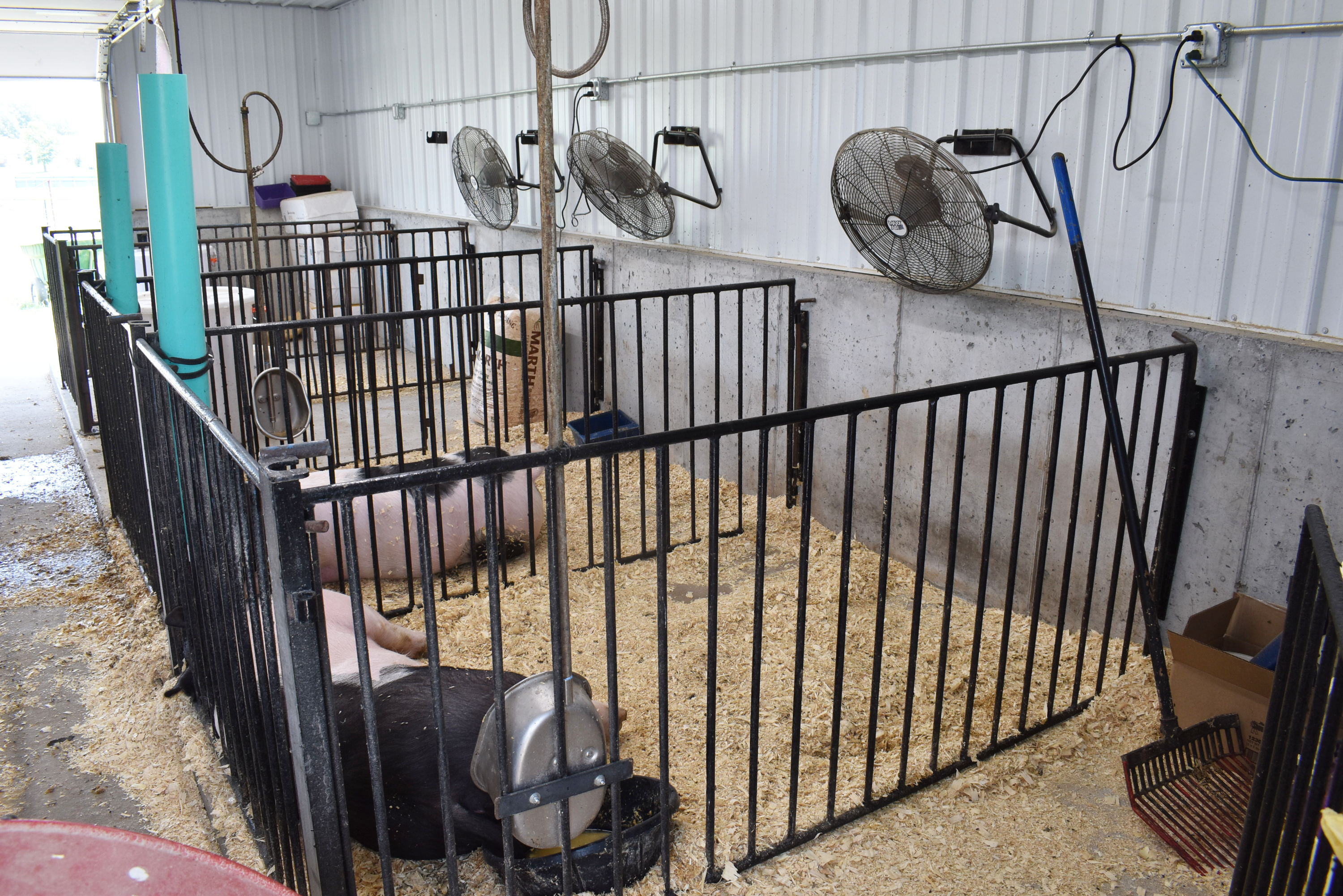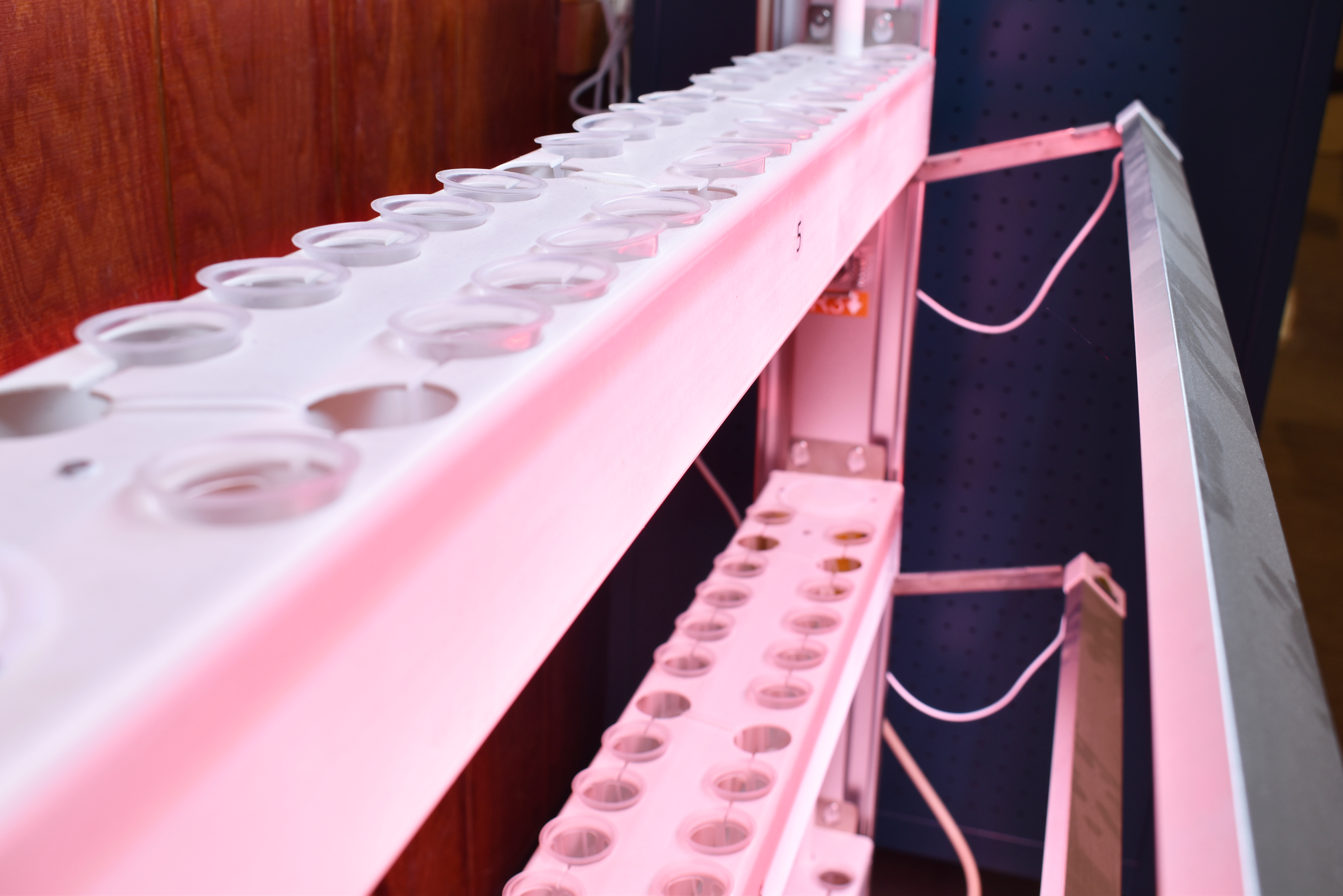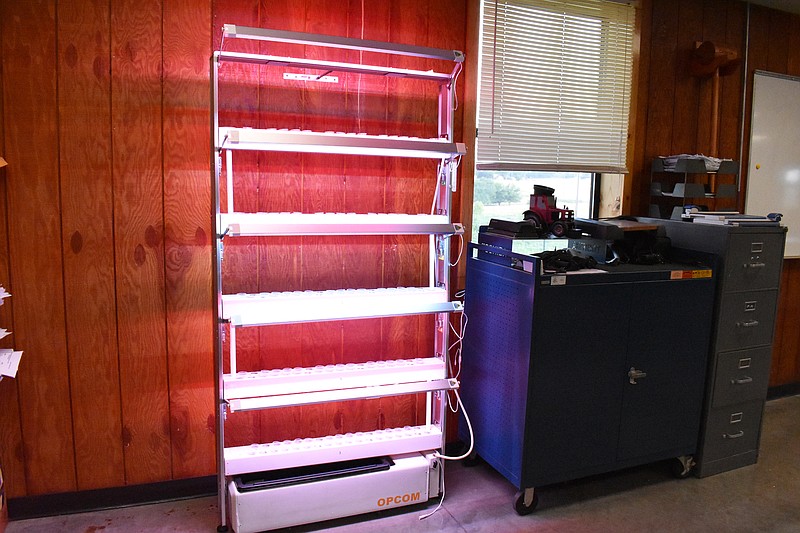California High School is expanding hands-on opportunities for agriculture students.
After dedicating the Denker Livestock Education Center in May 2022, the high school agriculture department continues to grow additional learning opportunities for students. It added a swine barn last school year, and this year students will experiment with a different way of growing plants along with tackling new projects.
California plant science students will notice new shelves in agriculture instructor Gary Morris' classroom. The shelves are part of an indoor hydroponic system, which involves growing plants in water with artificial lighting.
According to the U.S. Department of Agriculture (USDA), hydroponics is a "technique of growing plants using a water-based nutrient solution rather than soil." The technique is often utilized in specialty applications, Morris said. Many vegetables and fruits, such as lettuce and tomatoes, can be grown using hydroponics.
"To be honest, I've never had much experience with hydroponics, so that's something we're trying this year just to kind of see how much difference there is growing under artificial lights and using a soil-less-type growing method as opposed to growing in the traditional greenhouse our kids are used to," he said.
The hydroponic system, which consists of shelving for small plastic cups, was purchased last year with a state grant helping the district pay $1,000 for the equipment, Morris said. A water-based nutrient solution, which the USDA said consists of an "aggregate substrate" (or growing media) of vermiculite, coconut coir or perlite, is placed into the cup with a seed. Water flows through channels in the shelves, which also feature controllable lights for the plants.
Morris said he was hoping to have the system running by the spring semester, but technical issues and waiting for replacement parts postponed using it. However, with the hydroponic system now fully functional, he believes options with the technique could be almost limitless.
"Due to the fact that we're going to be able to keep it here in the classroom where the temperature is somewhat controlled, and also we're going to be providing artificial lights so we're not really worried about the short days in the fall or winter, I think it's going to be kind of limitless as far as how much we can utilize it," Morris said. "I also discussed it with some other ag teachers that are currently, or that had experience with hydroponics in the past, and so I've gotten some of their feedback. A lot of times they grow crops kind of throughout the majority of the school year."
Morris said his principles of plant science class will be doing most of the work with the hydroponic system, with the greenhouse students sticking to the traditional technique. However, he added, students in the greenhouse will have additional experiments of their own.
For instance, Morris said, greenhouse students will be measuring light and nutrients in the fall to see how they affect plant sales in the spring.
Expanding opportunities for agriculture students isn't limited to plant sciences. Students are also receiving hands-on experience with a variety of livestock, along with meat processing in the department's food science lab.
Gary Reichel, a CHS agriculture teacher specializing in animal science, explained the Denker Livestock Education Center (named for a previous California High School agriculture instructor, Robert Denker) is used for in-class training and activities with all kinds of livestock. He said students experience performing general livestock practices -- vaccinations, worming, ear-tagging and castrations -- among other things while utilizing the large animal handling part of the facility.
In addition to cattle and other large livestock, the facility also separately houses small animals -- such as sheep and goats -- owned and maintained by students. Having a place for students to keep their project animals was a big feature of the facility, as it opened a door to many opportunities for students who lack space at home.
"That's the nice thing about how we've been able to involve and include students from all aspects of the industry," Reichel said. "They can utilize our facilities and learn those skills that they wouldn't get to if they didn't live on a farm at home and try to replicate those."
Recognizing the need for additional space to keep students' project pigs, the high school agriculture department broke ground on a separate swine barn earlier this year. Students did most of the work constructing the facility, which was funded by a $5,000 MFA Foundation donation matched by the local MFA cooperative. The facility has 12 pens, each of which can house two pigs.
Reichel said the facility is now home to six pigs owned by students, who are responsible for the animals.
"They've been coming in watering and feeding morning and nights, and cleaning pens, taking care of their hogs just like they would if they had their own farm, and it kind of simulates that," he said. "All of the students that have hogs here live in town, so they don't have access to a farm at home. So this has been able to give them that hands-on experience by being able to have it here at the school."
Many of the pigs are grown for showing at fairs, such as the upcoming Moniteau County Fair, and other livestock exhibitions.
Reichel said his students will also be performing new projects, such as utilizing radio frequency identification (RFID) on cattle to measure feeding patterns.
"Basically we're going to be able to utilize some of the crops that we're raising, our corn and silages and haylages, and we're going to feed calves and get feed data on them," he said. Feed will be produced from the 2½ acres of corn adjacent to the high school agriculture facilities. "So a producer could bring in one or two calves for a couple weeks and we could feed them and give (the producer) that data."
The feed data, Reichel continued, can be used to help the producer make decisions based on how much feed it takes for the animal to gain weight.
"(The producer could take) that data that our students are going to learn in class, see how the data is made, give that back to the local producers and they can actually use that for management decisions in their own herds, of learning 'Hey, this calf was sired by bull A and this calf was bull C, maybe I want to get rid of bull C because his calves are taking too much feed to gain (weight) and focus more on bull A," he said.
Animal science links hand-in-hand with food science, Reichel said. He said with California being known as the "country-cured ham capital of the world with Burgers' Smokehouse" and having Cargill, a turkey processing plant, it was important to also teach meat processing as students may end up working at such a facility.
"We're able to try to teach those skills that a lot of students that would go to work in those facilities (would need)," he said. "We can try to do some of the basic skills in terms of slicing hams or curing some bacons, or even like during poultry season we identify different poultry parts throughout the food science lab as well. ... A lot of those kids are going to go to work for those businesses in our community, so if they learn some of these skills they can start out pretty good with those businesses as well."
In addition to slicing, curing and working with various kinds of meat, Reichel said his food science class also learns about other foods, such as canning vegetables or baking. The lab is a small-scale lab that allows students to produce custom products, such as deer jerky and deer summer sausage. While some learn how to make the products at home, others get to try the processes themselves at school.
Reichel said the agriculture department tries to stay up to date with the latest technology and trends in the industry. In addition to new food science equipment, Morris added the new equipment has also arrived for the department's wood shop.
"We're continually trying to kind of build the equipment that we have to try to provide as many opportunities to our kids as possible," Morris said. "I always say that we're very fortunate in this school district that I think what we have, as far as equipment wise, is as good as any school that you will find in our ag department. And I think our goal as advisers, as ag teachers, is to utilize that the best we can to provide opportunities and experiences for our kids that they will be able to utilize that in whatever field they choose to move forward in."
 Democrat photo/Garrett Fuller — Pigs are seen sleeping July 19 in their pens inside California High School's new swine barn. The barn, constructed this spring by agriculture students with help from a local contractor and funding donated by MFA, can house up to 24 pigs in 12 pens. Students without space at home can keep their project pigs in the barn, giving them the opportunity to learn about caring for swine.
Democrat photo/Garrett Fuller — Pigs are seen sleeping July 19 in their pens inside California High School's new swine barn. The barn, constructed this spring by agriculture students with help from a local contractor and funding donated by MFA, can house up to 24 pigs in 12 pens. Students without space at home can keep their project pigs in the barn, giving them the opportunity to learn about caring for swine. Democrat photo/Garrett Fuller — Plastic cups are seen July 19 inside California High School's new indoor hydroponic growing system. A water-based nutrient solution in an aggregate substrate is planted in the cup with a seed. As water flows through the system's shelves, and the artificial lights shine over the cups, the seeds will eventually blossom. Gary Morris, a CHS agriculture instructor, said a variety of plants — including tomatoes and lettuce — can be grown using the hydroponic technique.
Democrat photo/Garrett Fuller — Plastic cups are seen July 19 inside California High School's new indoor hydroponic growing system. A water-based nutrient solution in an aggregate substrate is planted in the cup with a seed. As water flows through the system's shelves, and the artificial lights shine over the cups, the seeds will eventually blossom. Gary Morris, a CHS agriculture instructor, said a variety of plants — including tomatoes and lettuce — can be grown using the hydroponic technique.
